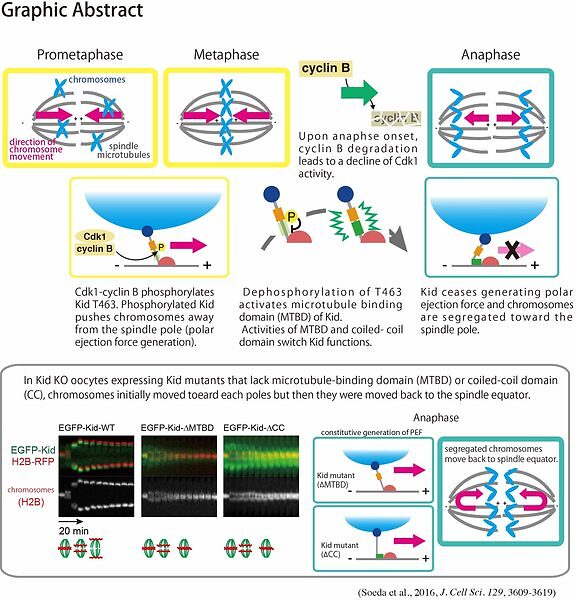Seminar "Dephosphorylation-mediated functional switching of chromokinesin Kid/KIF22 ensures chromosome segregation"

Date
Location
Description
Speaker: Dr. Sho Soeda
Researcher, Department of Life Sciences, Graduate School of Arts and Sciences, The University of Tokyo
Title: Dephosphorylation-mediated functional switching of chromokinesin Kid/KIF22 ensures chromosome segregation.
Abstract: The dynamic movement of mitotic chromosomes along the spindle microtubules is achieved by forces generated by microtubule dynamicity and several motor proteins. In addition to the forces acting on the kinetochores through the attached microtubules, the forces generated on the chromosome arms contribute to the congression and alignment of the chromosomes during prometaphase and metaphase. The chromokinesin Kid/KIF22 is a plus end-directed motor protein characterized by a DNA-binding domain. During prometaphase and metaphase, Kid is implicated in chromosome congression and alignment through generation of a polar ejection force (PEF) on the chromosome arms. Besides the motor domain, Kid has a second microtubule-binding domain (MTBD), which is inhibited by T463 phosphorylation by Cdk1, between the motor and coiled-coil (CC) domains. These domains are required for balanced localization of Kid on spindle microtubules and chromosomes. PEF generation by Kid must be suppressed during anaphase in order to segregate chromosomes, however how this is achieved is unclear. Here we address this question by expressing mutant forms of Kid in Kid-deficient cells.
In Kid-KO fibroblast cells expressing phosphorylation-defective Kid-T463A mutant, mitotic chromosomes were centered on monopolar spindles whereas they were ejected from the pole in the cells expressing Kid-WT. When Kid-KO oocytes expressing phosphorylation-mimetic Kid-T463D mutant entered anaphase, chromosomes initially moved toward each pole, but then separated chromosomes moved back to the spindle equator. The expression of Kid-ΔMTBD or Kid-ΔCC also resulted in this chromosome recongression phenotype. These results suggest that Cdk1-mediated phosphorylation of Thr463 is required to generate PEF on Kid-binding chromosomes during metaphase and that Thr463 must be dephosphorylated in order to prevent untimely PEF generation during anaphase. In addition to the MTBD activated by Thr463-dephosphorylation, the CC domain is essential to turn off PEF generation, and thereby prevent separated chromosomes from becoming recongressed during anaphase.
We propose that dephosphorylation of Thr463 during the metaphase-anaphase transition converts the Kid functional mode from PEF-ON to -OFF and thereby switches the mitotic chromosome movement from anti-poleward to poleward, and that both the MTBD and the CC domain are the operation units involved in this switching process.
Subscribe to the OIST Calendar: Right-click to download, then open in your calendar application.



